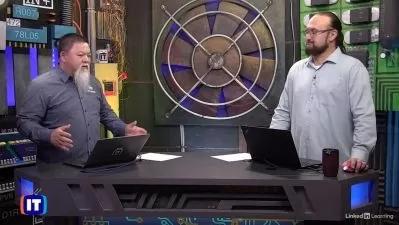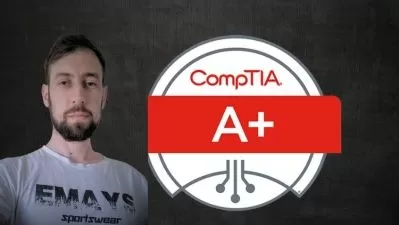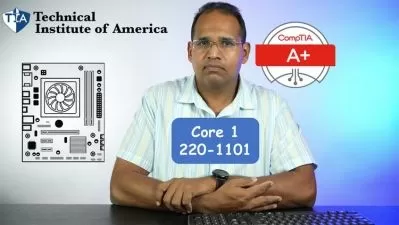CompTIA A+ Core 2 (220-1102) Complete Course & Practice Exam
Jason Dion • 1 Million+ Enrollments Worldwide,Dion Training Solutions • ATO for ITIL & PRINCE2
35:48:54
Description
Pass the CompTIA A+ (220-1102) Core 2 exam with help from a top expert in the field!
What You'll Learn?
- How to pass the CompTIA A+ (220-1102) Core 2 exam on your first attempt
- What your weak areas are in the CompTIA A+ curriculum so you can restudy those areas
- Install, configure, and maintain computer equipment, mobile devices, and software for end users
- Service components based on customer requirements
- Understand networking basics and apply basic cybersecurity methods to mitigate threats
- Properly and safely diagnose, resolve, and document common hardware and software issues
- Apply troubleshooting skills and provide customer support using appropriate communication skills
- Understand the basics of scripting, cloud technologies, virtualization, and multi-OS deployments in corporate environments
Who is this for?
More details
Description*** Taught by a Best Selling Certification Instructor ***
This course provides everything you need in order to study for the CompTIA A+ Core 2 (220-1102) exam, including a downloadable Study Guide (PDF), quizzes to check your knowledge as you progress through the videos, and a full-length practice exam to test your knowledge before test day!
Jason Dion is an expert in information technology and cybersecurity with over 20 years of experience, and he has designed this course to be a fun way to learn what you need to know to pass the CompTIAÂ A+ Core 2 (220-1102)Â exam or to better prepare yourself to serve as a service analyst or computer technician in your organization information technology (IT) divisions.
The CompTIA A+ Core 2 (220-1102) certification is a vendor-neutral certification that validates your knowledge and ability to conduct install, configure, and troubleshoot software and operating system issues in your organization. This certification tests your ability to think on your feet while performing critical IT support functions. The CompTIA A+ certification is designed for early-career data analysts with the equivalent of 9-12 months of on-the-job knowledge.
The CompTIAÂ A+Â Core 2 exam is focused on supporting operating systems and software in order to support a wide variety of different devices used by a diverse and global workforce.Â
CompTIAÂ A+ Core 2 (220-1102) is an early-career IT support technician certification covering the theory and technical skills required to support operating system, applications, and security in a corporate environment using the proper operational procedures.
To help you practice for the CompTIA A+ Core 2 (220-1102) exam, this course even comes with a realistic practice exam containing 90 multiple-choice questions spread across the four domains tested by the CompTIA A+ Core 2 (220-1102) certification exam!    Â
This course will provide you with full coverage of the five domains of the CompTIA A+ Core 2 (220-1102) exam: Â
Operating Systems (31%)
Security (25%)
Software Troubleshooting (22%)
Operational Procedures (22%)
This course stays current and up-to-date with the latest release of the CompTIA A+ Core 2 exam (220-1102), and also provides a 30-day money-back guarantee if you are not satisfied with the quality of this course for any reason!
This course is brought to you by Dion Training Solutions, a CompTIAÂ Platinum Delivery Partner, and aligns directly with the OFFICIAL CompTIAÂ A+ (220-1102) Certification Study Guide.
What Other Students Are Saying About Our Courses:
Jason's courses are immensely helpful - they dramatically expedite the learning process (this is my second certification that I've used Jason's resources to study for). The practice exams not only cover the full range of subject matter, but they also are structured in the same manner as those that can be expected on exam day using real-life scenarios and encouraging the mind to apply the knowledge more flexibly than just memorization/repeat learning. (Holly, 5 stars)
Great course, very detailed. Passed the exam on the first try. I have recommended this course to everyone I know. (Jose D., 5 stars)
I passed on 1st try, that's all I can ask for! (Tim, 5 stars)
Who this course is for:
- Anyone looking to take and pass the CompTIA A+ (220-1102) Core 2 certification exam
*** Taught by a Best Selling Certification Instructor ***
This course provides everything you need in order to study for the CompTIA A+ Core 2 (220-1102) exam, including a downloadable Study Guide (PDF), quizzes to check your knowledge as you progress through the videos, and a full-length practice exam to test your knowledge before test day!
Jason Dion is an expert in information technology and cybersecurity with over 20 years of experience, and he has designed this course to be a fun way to learn what you need to know to pass the CompTIAÂ A+ Core 2 (220-1102)Â exam or to better prepare yourself to serve as a service analyst or computer technician in your organization information technology (IT) divisions.
The CompTIA A+ Core 2 (220-1102) certification is a vendor-neutral certification that validates your knowledge and ability to conduct install, configure, and troubleshoot software and operating system issues in your organization. This certification tests your ability to think on your feet while performing critical IT support functions. The CompTIA A+ certification is designed for early-career data analysts with the equivalent of 9-12 months of on-the-job knowledge.
The CompTIAÂ A+Â Core 2 exam is focused on supporting operating systems and software in order to support a wide variety of different devices used by a diverse and global workforce.Â
CompTIAÂ A+ Core 2 (220-1102) is an early-career IT support technician certification covering the theory and technical skills required to support operating system, applications, and security in a corporate environment using the proper operational procedures.
To help you practice for the CompTIA A+ Core 2 (220-1102) exam, this course even comes with a realistic practice exam containing 90 multiple-choice questions spread across the four domains tested by the CompTIA A+ Core 2 (220-1102) certification exam!    Â
This course will provide you with full coverage of the five domains of the CompTIA A+ Core 2 (220-1102) exam: Â
Operating Systems (31%)
Security (25%)
Software Troubleshooting (22%)
Operational Procedures (22%)
This course stays current and up-to-date with the latest release of the CompTIA A+ Core 2 exam (220-1102), and also provides a 30-day money-back guarantee if you are not satisfied with the quality of this course for any reason!
This course is brought to you by Dion Training Solutions, a CompTIAÂ Platinum Delivery Partner, and aligns directly with the OFFICIAL CompTIAÂ A+ (220-1102) Certification Study Guide.
What Other Students Are Saying About Our Courses:
Jason's courses are immensely helpful - they dramatically expedite the learning process (this is my second certification that I've used Jason's resources to study for). The practice exams not only cover the full range of subject matter, but they also are structured in the same manner as those that can be expected on exam day using real-life scenarios and encouraging the mind to apply the knowledge more flexibly than just memorization/repeat learning. (Holly, 5 stars)
Great course, very detailed. Passed the exam on the first try. I have recommended this course to everyone I know. (Jose D., 5 stars)
I passed on 1st try, that's all I can ask for! (Tim, 5 stars)
Who this course is for:
- Anyone looking to take and pass the CompTIA A+ (220-1102) Core 2 certification exam
User Reviews
Rating
Jason Dion • 1 Million+ Enrollments Worldwide
Instructor's CoursesDion Training Solutions • ATO for ITIL & PRINCE2
Instructor's Courses
Udemy
View courses Udemy- language english
- Training sessions 298
- duration 35:48:54
- Release Date 2023/01/22











